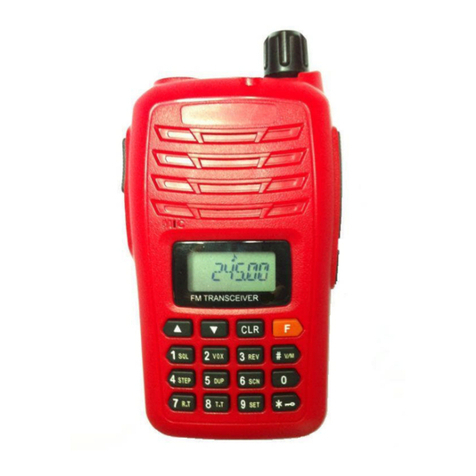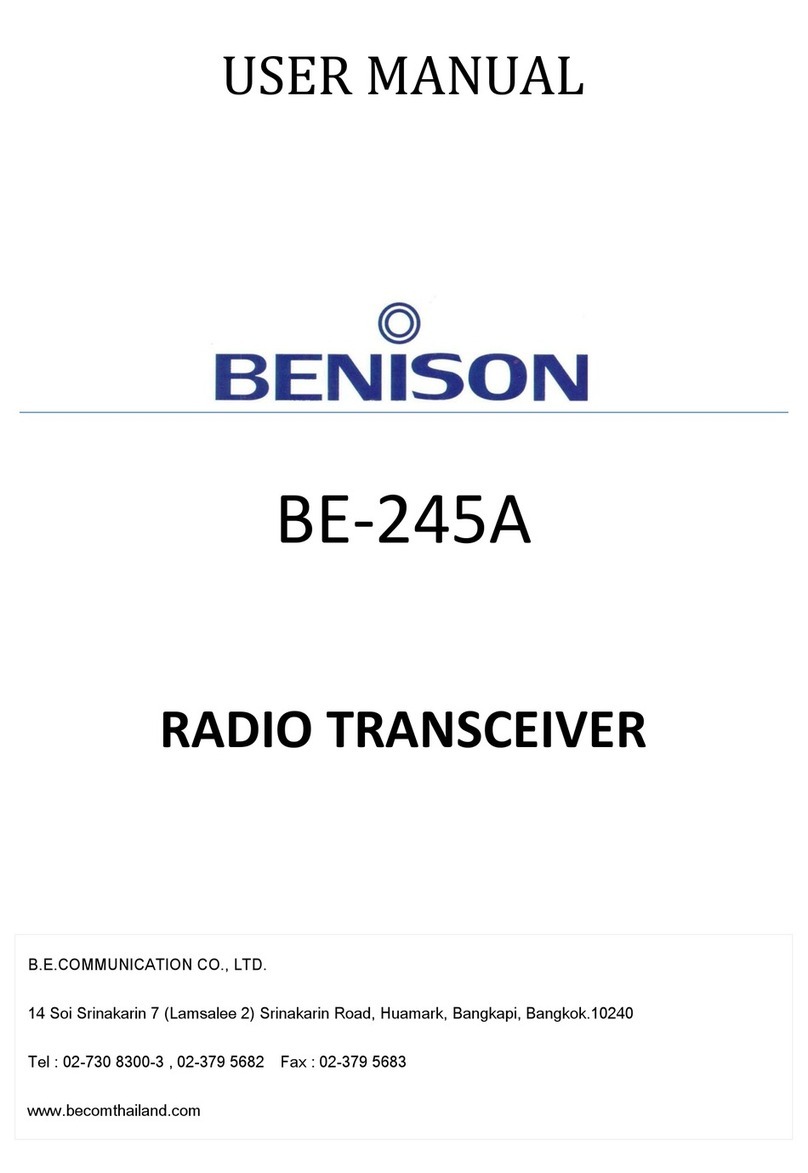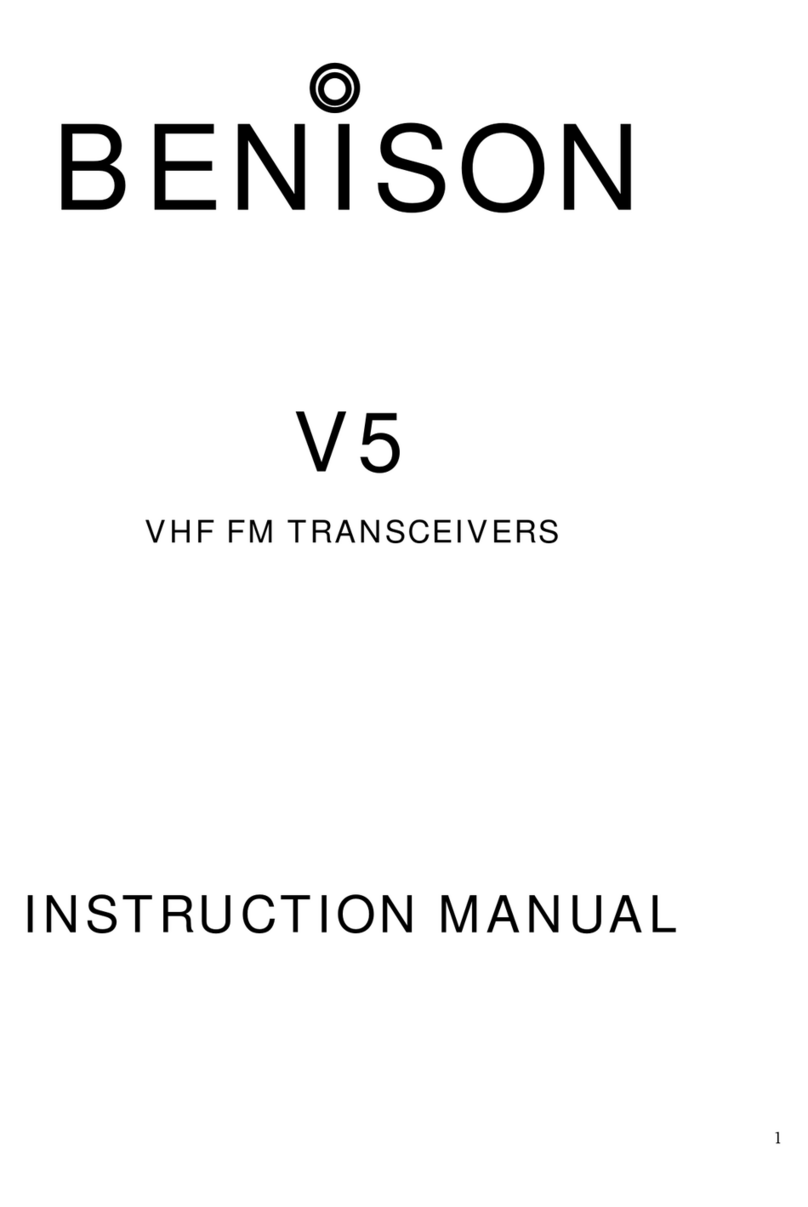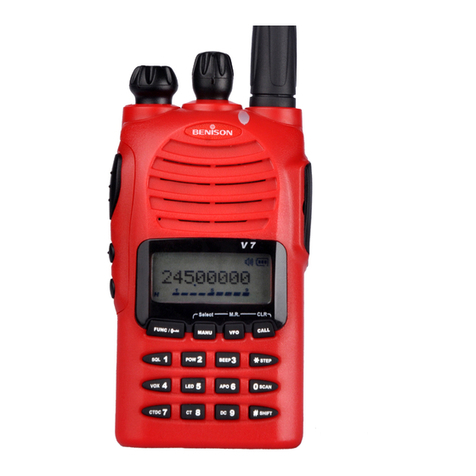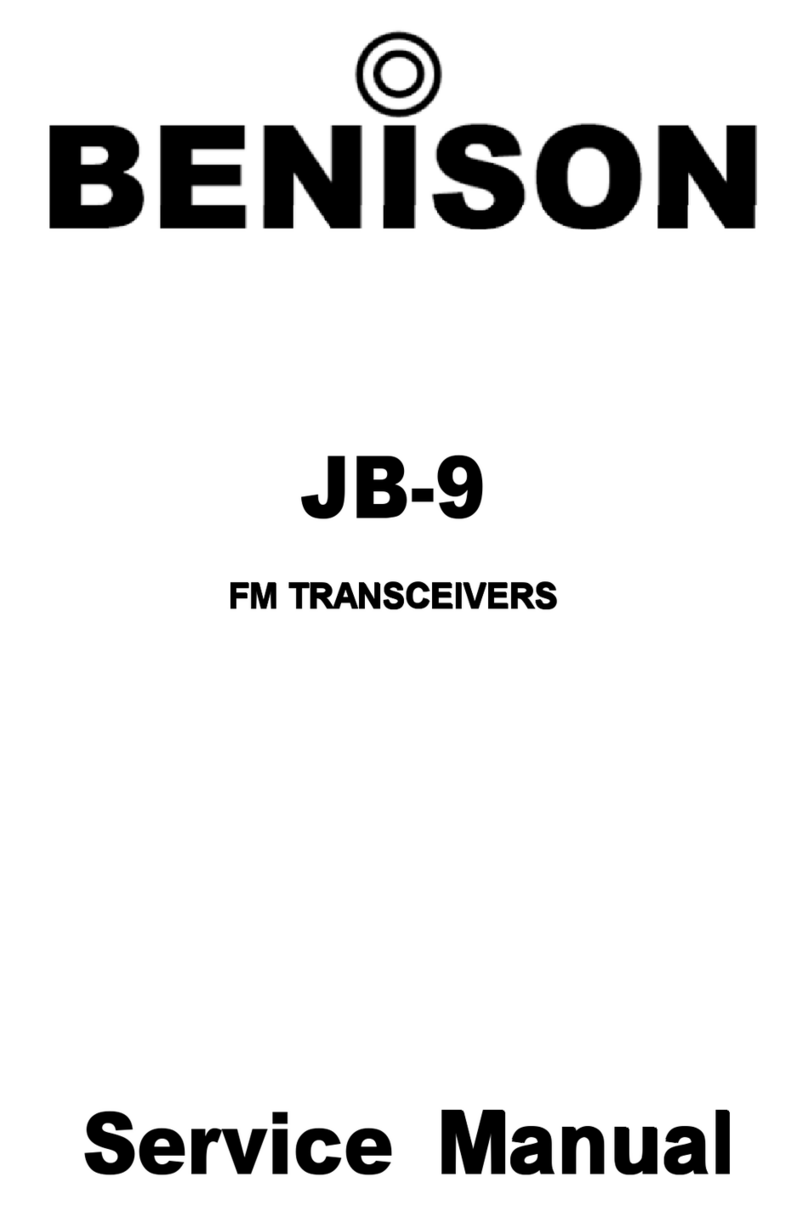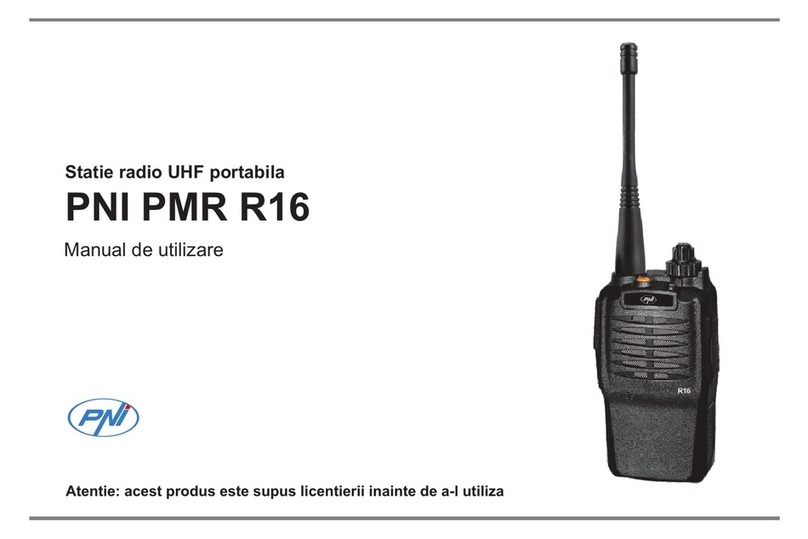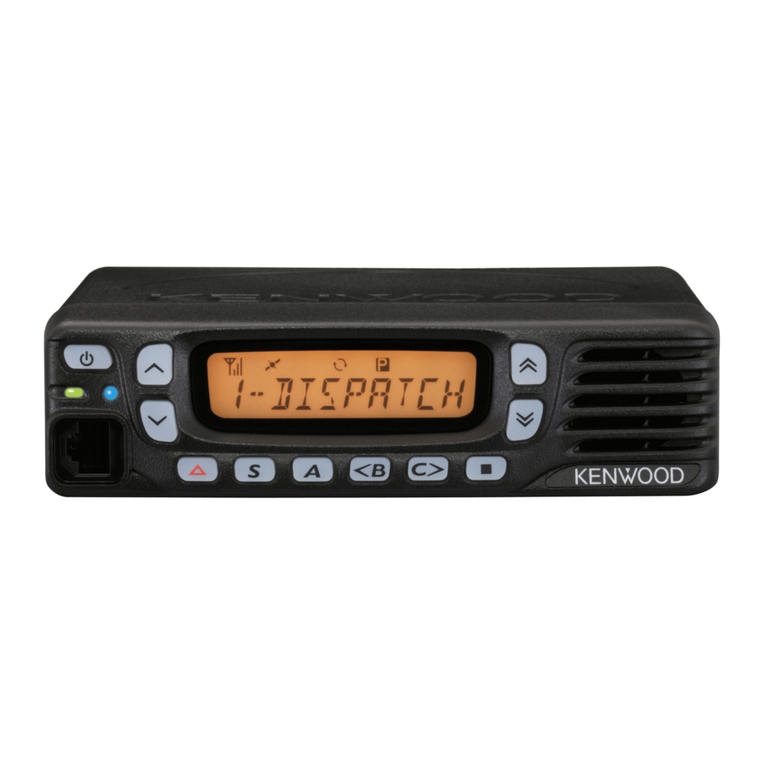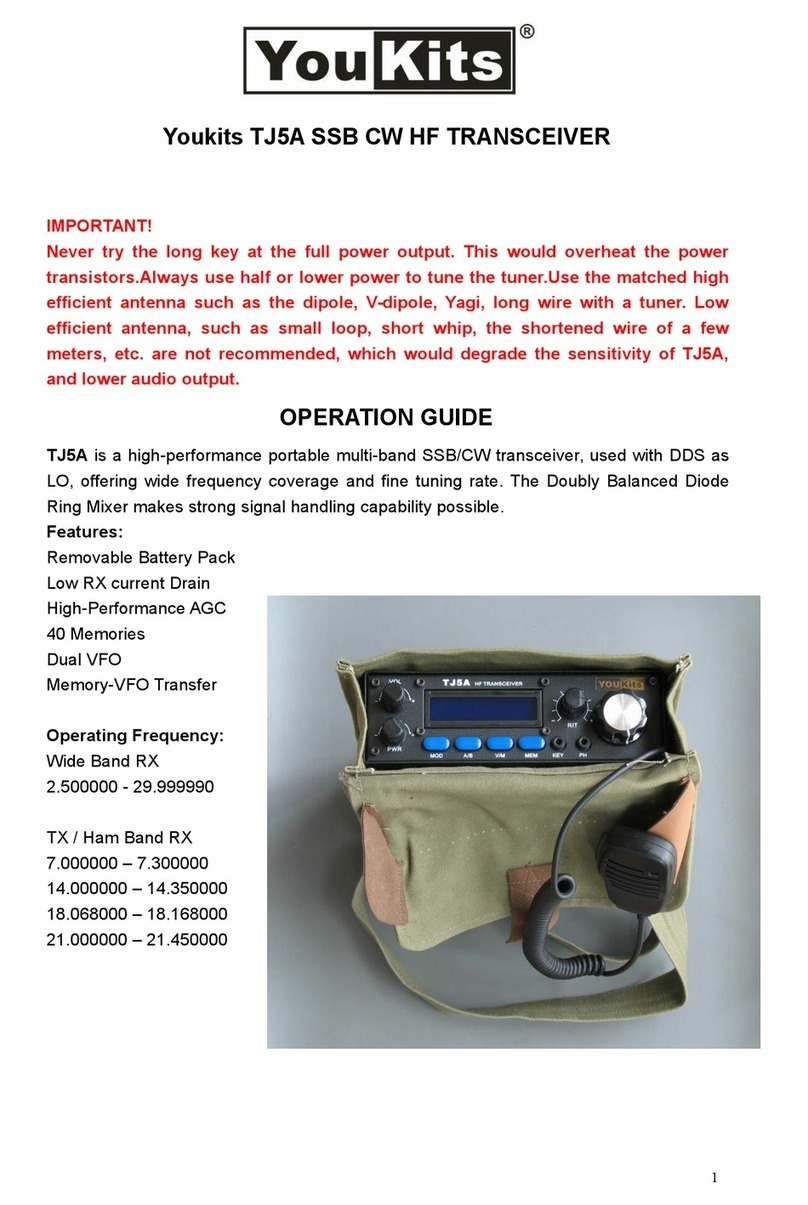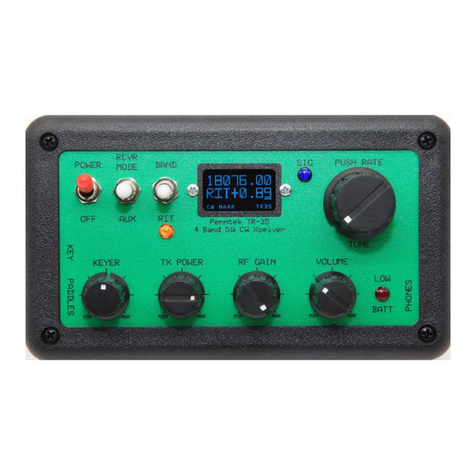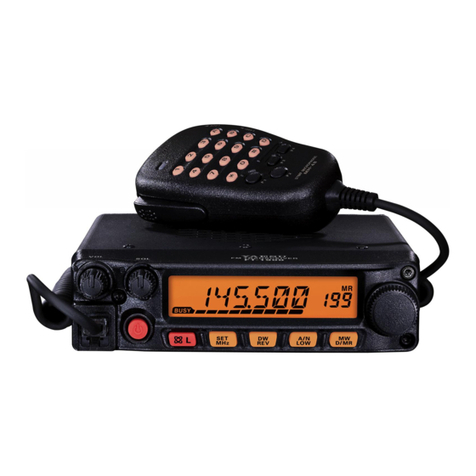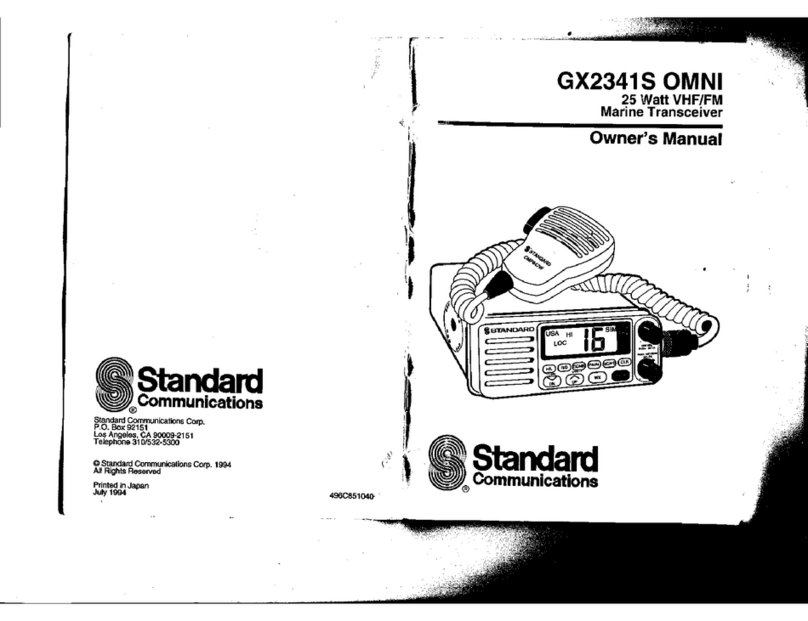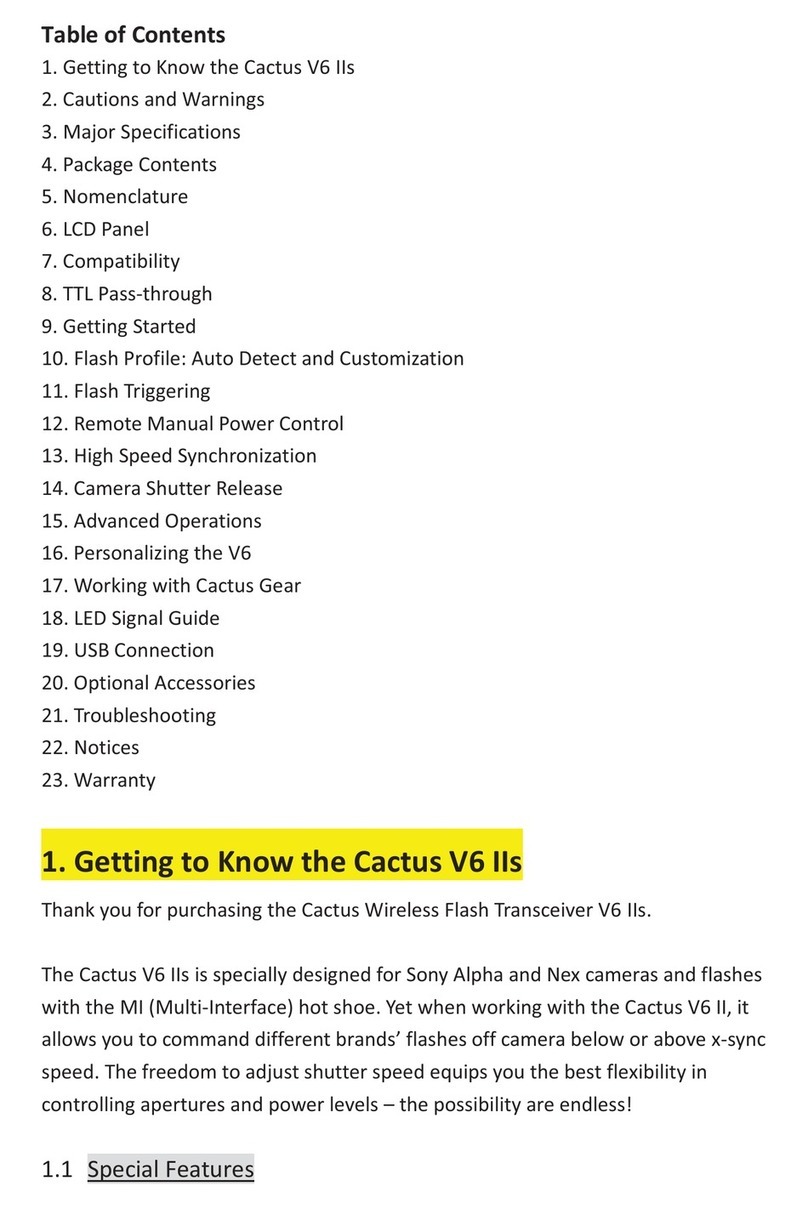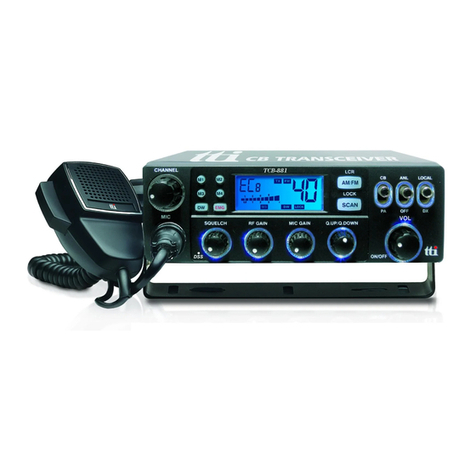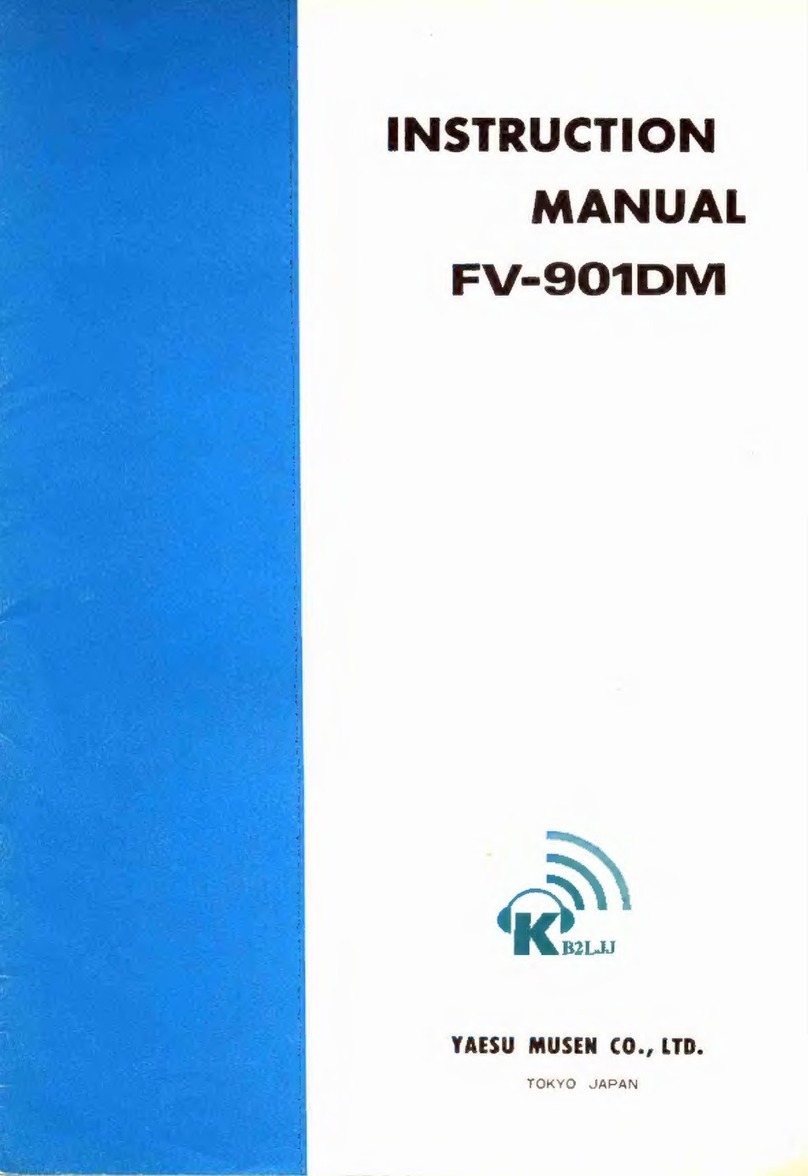Benison V9-S User manual


Communication Equipment
Himmelgeister Str. 100, D-40225 Düsseldorf, Germany
Phone:0211 346047 Fax : 0211 333639
URL : http://www.icomeurope.com
Unit 9, Sea St., Herne Bay, Kent, CT6 8LD, U.K.
Phone:01227 741741 Fax : 01227 741742
URL : http://www.icomuk.co.uk
Zac de la Plaine, Rue Brindejonc des Moulinais
BP 5804, 31505 Toulouse Cedex, France
Phone:561 36 03 03 Fax : 561 36 03 00
URL : http://www.icom-france.com
Crta. de Gracia a Manresa Km.14,750
08190 Sant Cugat del Valles Barcelona, SPAIN
Phone : (93)590 26 70 Fax : (93)589 04 46
URL : http://www.icomspain.com
<
Corporate Headquarters
>
2380 116th Avenue N.E., Bellevue, WA 98004, U.S.A.
Phone : (425)454-8155 Fax : (425)454-1509
URL : http://www.icomamerica.com
<
Customer Service
>
Phone : (425)454-7619
Glenwood Centre #150-6165
Highway 17 Delta, B.C., V4K 5B8, Canada
Phone : (604)952-4266 Fax : (604)952-0090
URL : http://www.icomcanada.com
A.B.N.88 006 092 575
290-294 Albert Street, Brunswick, Victoria, 3056, Australia
Phone:03 9387 0666 Fax : 03 9387 0022
URL : http://www.icom.net.au
146A Harris Road, East Tamaki,
Auckland, New Zealand
Phone:09 274 4062 Fax : 09 274 4708
URL : http://www.icom.co.nz 6F No.68, Sec.1 Cheng-Teh Road, Taipei, Taiwan, R.O.C.
Phone:(02) 2559 1899 Fax : (02) 2559 1874
1-1-32, Kamiminami, Hirano-ku, Osaka 547-0003, Japan
Phone : 06 6793 5302
Fax : 06 6793 0013
URL : http://www.icom.co.jp/world/index.html
INTRODUCTION
DANGER
ORDERING PARTS
REPAIR NOTES
This service manual describes the latest service information
for the
V9-
S
at the time of publication.
NEVER connect the transceiver to an AC outlet or to a DC
power supply that uses more than 10.3 V. Such a connection
could cause a fire hazard and/or electric shock.
DO NOT expose the transceiver to rain, snow or any liquids.
DO NOT reverse the polarities of the power supply when con-
necting the transceiver.
DO NOT apply an RF signal of more than 20 dBm (100mW)
to the antenna connector. This could damage the transceiv-
er’s front end.
Be sure to include the following four points when ordering
replacement parts:
1. 10-digit order numbers
2. Component part number and name
3. Equipment model name and unit name
4. Quantity required
<SAMPLE ORDER>
0910053802 PCB B-5649B
V9-S
MAIN UNIT 1 pieces
8810009560 Screw BT M2 x 6 ZK
V9
-S
Chassis 10 pieces
8810009510 Screw BT 2 x 4 NI
V9
-S
Chassis 10 pieces
Addresses are provided on the inside back cover for your
convenience.
1. Make sure a problem is internal before disassembling the transceiver.
2. DO NOT open the transceiver until the transceiver is disconnected from its power source.
3. DO NOT force any of the variable components. Turn them slowly and smoothly.
4. DO NOT short any circuits or electronic parts. An insulated turning tool MUST be used for all adjustments.
5. DO NOT keep power ON for a long time when the transceiver is defective.
6. DO NOT transmit power into a signal generator or a sweep generator.
7. ALWAYS connect a 40 dB to 50 dB attenuator between the transceiver and a deviation meter or spectrum analyzer when
using such test equipment.
8. READ the instructions of test equipment thoroughly before connecting equipment to the transceiver.
To upgrade quality, all electrical or mechanical parts and
internal circuits are subject to change without notice or oblig-
ation.

TABLE OF CONTENTS
SECTION 1 SPECIFICATIONS
SECTION 2 INSIDE VIEWS
SECTION 3 DISASSEMBLY INSTRUCTIONS
SECTION 4 CIRCUIT DESCRIPTION
4 - 1 RECEIVER CIRCUITS ................................................................................................... 4 - 1
4 - 2 TRANSMITTER CIRCUITS ............................................................................................ 4 - 2
4 - 3 PLL CIRCUIT................................................................................................................... 4 - 3
4 - 4 OTHER CIRCUITS.......................................................................................................... 4 - 3
4 - 5 POWER SUPPLY CIRCUITS ......................................................................................... 4 - 3
4 - 6 CPU PORT ALLOCATIONS ........................................................................................... 4 - 4
SECTION 5 ADJUSTMENT PROCEDURES
5 - 1 PREPARATION................................................................................................................ 5 - 1
SECTION 6 PARTS LIST
SECTION 7 MECHANICAL PARTS AND DISASSEMBLY
SECTION 8 SEMI-CONDUCTOR INFORMATION
SECTION 9 BOARD LAYOUTS
9 - 1 MAIN UNIT....................................................................................................................... 9 - 1
SECTION 10 BC-146 OPTIONAL DESKTOP CHARGER INFORMATION
10 - 1 PARTS LIST................................................................................................................... 10 - 1
10 - 2 DISASSEMBLY INFORMATION.................................................................................... 10 - 1
10 - 3 VOLTAGE DIAGRAM..................................................................................................... 10 - 2
10 - 4 BOARD LAYOUT........................................................................................................... 10 - 2
SECTION 11 BLOCK DIAGRAM
SECTION 12 VOLTAGE DIAGRAM

SECTION 1 SPECIFICATIONS
1 - 1
‘‘GENERAL
• Frequency coverage :
*Specifications Guaranteed: 144.0000–146.9875 MHz only
• Type of emission : F2D/ F3E
• Frequency stability : ± 10 ppm
(–10˚C to +60˚C; +14˚F to +140˚F)
• Tuning steps : 5, 10, 12.5, 15, 20, 25, 30 or 50 kHz
• Antnna connector : BNC (50)Ω
• Power supply requirement : 7.2 V DC (Operable voltage range: 6.0 to 10.3 V)
(negative ground)
• Number of memory channel : 100 channels
• Call channel : 1 channel
• Scanning mode : Program, Memory, Skip, Priority or Tone
• Current drain (approx.) : Transmit at High (5 W) 1.7A
at Low (1W) 0.7 A
Receive Max. audio 250 mA
stand-by 70 mA
power saved 20 mA
• Usable temperature range : –10˚C to +60˚C; +14˚F to +140˚F
• Dimensions (projections not included) : 54(W)
× 132(H) × 35(D) mm; 2 1⁄8(W) × 5 3⁄16(H) × 1 3⁄8(D) in.
•Weight (with ant., BP-222) : 350 g; 12.3 oz.
‘‘TRANSMITTER
•RF output power (at 7.2 V DC) : 5W / 1W (High / Low)
(with supplied battery pack)
•Modulation system : Variable reactance frequency modulation
•Maximum frequency deviation : ±2.5kHz
•Spurious emissions : Less than –60 dB
•Ext. microphone connector : 3-conductor 2.5(d) mm (1⁄10”)/2.2 kΩ
‘‘RECEIVER
•Receive system : Double conversion superheterodyne system
•Intermediate frequencies : 1st 38.85 MHz
2nd 450 kHz
•Sensitivity : 0.16 µV at 12 dB SINAD (typical)
•Squelch sensitivity : 0.1 µV at threshold (typical)
•Adjacent channel selectivity : 65 dB (typical)
•Spurious response rejection : 75 dB (typical)
•Intermodulation rejection ratio : 65 dB (typical)
•Audio output power (at 7.2 V DC) : More than 300 mW at 10% distortion with an 8 Ωload
•Ext. speaker connector : 3-conductor 3.5(d) mm (1⁄8”)/8 Ω
All stated specifications are subject to change without notice or obligation.
Receive
136.000–174.000 MHz*
Transmit
136.0000–174.000 MHz
136.0000–174.000 MHz*
Version
[USA]
[GEN]

2-1
SECTION 2 INSIDE VIEWS
Power amplifier
(Q1: 2SK3476)
Antenna swtching circuit
(D2, D8: MA77)
Antenna swtching circuit
(D1: MA77)
TOP VIEW BOTTOM VIEW
RF amplifier
(Q12: 3SK274)
VCO circuit
1st mixer
(Q13: 3SK274)
TX/RX switch
(D3, D4: MA77)
APC
IC3A: NJM12902V
Q37: DTA144EU
FM IF IC
(IC2:TA31136FN)
CPU
(IC8: SX78P678AQ)
EEPROM
(IC7: BR24C16FV)
D/A converter
(IC10: M62363FP)
PLL reference oscillator
(X1: CR-659 21.25 MHz)
Crystal filter
FI1, Fl3:FL-298
21.700 MHz
PLL IC
(IC1:LV2105V)
IF amplifier
(Q14: 2SC4406)
( )
( )

3-1
SECTION 3 DISASSEMBLY INSTRUCTIONS
3-1 DISASSEMBLY INSTRUCTION
• REMOVING THE CHASSIS PANEL
1Unscrew 1 nut A, and remove 1 knob B.
2Unscrew 2 screws C.
3Take off the chassis in the direction of the arrow.
4Unplug J6 to separate front panel and chassis.
• REMOVING THE MAIN UNIT
1
2Unsolder 3 points D, and unscrew 1 nut E.
3Unscrew 2 screws F, 2 screws H, and 6 screws G (silver, 2 mm) to separate the chassis and the MAIN unit.
(black, 2 mm) x 2
Front panel
Chassis
J6 (Speaker connector)
B
C
A
H(black, 2 mm) x 2
(silver, 2 mm) x 6
Shield cover
Guide holes
MAIN unit
Chassis
DDG
D
E
G
G
F(black, 2 mm) x 2
Take off the MAIN unit in the direction of the arrow.

3 - 2
3-2 OPTIONAL UNIT INSTALLATIONS
1Remove the option cover.
2Remove the bottom protective paper of spoge.
3Connect the UT-108 optional unit to J5.
4Replace the option cover to the chassis-hole.
SPONGE
Parts name : 1556 sponge
Order No. : 8930013545
Option cover
Option unit
J5

SECTION 4 CIRCUIT DESCRIPTION
4 - 1
4-1 RECEIVER CIRCUITS
4-1-1 ANTENNA SWITCHING CIRCUIT
Received signals passed through the low-pass filter (L1, L2,
C1–C5). The filtered signals are applied to the 1/4 λtype
antenna switching circuit (D1, D2, D8, L15, C76).
The antenna swtiching circuit functions as a low-pass filter
while transmitting. However, its impedance becomes very
high while D2 and D8 are turn ON. Thus transmit signals are
blocked from entering the receiver circuits. The antenna
switching circuit employs a 1/4 λtype diode swtiching sys-
tem. The passed signals are then applied to the RF amplifi-
er circuit.
4-1-2 RF CIRCUIT
The RF circuit amplifies signals within the range of frequen-
cy coverage and filters out-of-band signals.
The signals from the antenna switching circuit are applied to
the limitter (D50), and are then passed through the band-
pass filter (D9, L16, C80). The filtered signals are amplified
at the RF amplifier (Q12), then applied to the 1st mixer cir-
cuit after out-of-band signals are suppressed at the band-
pass filter (D11, D12, L19, C91–C97).
D9, D11, D12 employ varactor diodes that track the band-
pass filters and are controlled by the T1–T3 signals from the
D/A convertor (IC10, pins 2, 3, 10). These diodes tune the
center frequency of an RF passband for wide bandwidth
receiving and good image response rejection.
4-1-3 1ST MIXER AND 1ST IF CIRCUITS
The 1st mixer circuit converts the received signal to a fixed
frequency of the 1st IF signal with a PLL output frequency.
By changing the PLL frequency, only the desired frequency
will pass through two crystal filters at the next stage of the
1st mixer.
The signals from the RF circuit are mixed at the 1st mixer
(Q13) with a 1st LO signal coming from the VCO circuit to
produce a 21.70 MHz 1st IF signal.
The 1st IF signal is applied to two crystal filters (FI1 and FI3)
to suppress out-of-band signals. The filtered 1st IF signal is
applied to the IF amplifier (Q14), then applied to the 2nd
mixer circuit (IC1, pin 16).
4-1-4 2ND IF AND DEMODULATOR CIRCUITS
The 2nd mixer circuit converts the 1st IF signal to a 2nd IF
signal. Adouble conversion superheterodyne system (which
converts receive signal twice) improves the image rejection
ratio and obtain stable receiver gain.
The 1st IF signal from the IF amplifier is applied to the 2nd
mixer section of the FM IF IC (IC2, pin 16), and is mixed with
the 2nd LO signal to be converted to a 450 kHz 2nd IF sig-
nal.
The FM IF IC contains the 2nd mixer, limiter amplifier, quad-
rature detector and active filter circuits.A21.25 MHz 2nd LO
signal is produced at the PLL circuit.
The 2nd IF signal from the 2nd mixer (IC2, pin 3) passes
through a ceramic filter (FI2) to remove unwanted hetero-
dyned frequencies. It is then amplified at the limiter amplifi-
er (IC2, pin 5) and applied to the quadrature detector (IC2,
pins 10, 11) to demodulate the 2nd IF signal into AF signals.
4-1-5 AF CIRCUIT
The AF amplifier circuit amplifies the demodulated AF sig-
nals to drive a speaker.
AF signals from the FM IF IC (IC2, pin 9) are applied to the
analog swtich (IC4, pin 1) via the AF filter circuit (IC3b, pins
6, 7). The output signals from pin 2, 3 are passed through
the low-pass filter (IC3d, pins 13, 14), and are then applied
to the analog swtich (IC4, pin 9, 10) again. The signals from
the IC4, pin 11 are applied to the AF power amplifier (IC5,
pin 4) after passing through the D/A convertor (IC10, pins
12, 11).
Mixer
16
Limiter
amp.
2nd IF filter
450 kHz PLL IC
IC1
X1
19.2 MHz
IC2 TA31136F
12 1st IF from the IF amplifier (Q14)
"SD" signal to the CPU pin 98
11109
87 5 3
AF signal "DET"
R5
X3
R86
C122 C121
R88R87
R83
"SQLIN" signal from the
D/A convertor (IC10, pin 23)
R82
C112 C113
C116
2
16 1
Active
filter
FI2
Noise
detector
FM
detector
13
"NOIS" signal to the CPU pin 19
RSSI
Noise
comp.
R84
LPF
• 2ND IF AND DEMODULATOR CIRCUITS

4 - 2
The AF signals are applied to the AF power amplifier circuit
(IC5, pin 4) to obtain the specified audio level. The amplified
AF signals, output from pin 10, are applied to the internal
speaker (SP1) via the speaker jack (CHASSIS unit; J3)
when no plug is connected to the jack.
4-1-6 SQUELCH CIRCUIT
Asquelch circuit cuts outAF signals when no RF signals are
received. By detecting noise components in the AF signals,
the squelch switches the analog swtich.
Aportion of theAF signals from the FM IF IC (IC2, pin 9) are
applied to the active filter section (IC2, pin 8) where noise
components are amplified and detected with an internal
noise detector.
The trigger circuit converts the detected signals to a HIGH
or LOW signal and applies this (from pin 13) to the CPU
(IC8, pin 19) as the NOIS signal. When the CPU receives a
HIGH level NOIS signal, the CPU controls the RMUT line to
cut theAF signals at the analog swtich IC (IC4).At the same
time, the AFON line controls the AF regulator circuit (Q15,
Q16) to cut out the VCC power source for the AF power
amplifier (IC5).
4-2 TRANSMITTER CIRCUITS
4-2-1 MICROPHONE AMPLIFIER CIRCUIT
The microphone amplifier circuit amplifies audio signals with
+6 dB/octave pre-emphasis from the microphone to a level
needed for the modulation circuit.
The AF signals from the microphone are applied to the
microphone amplifier circuit (IC3c, pin 10). The amplifiedAF
signals are passed through the low-pass filter circuit (IC3d,
pins 13, 14) via the analog swtich (IC4, pins 4, 3). The fil-
tered AF signals are applied to the modulator circuit after
passing through the analog swtich (IC4, pins 8, 9).
4-2-2 MODULATION CIRCUIT
The modulation circuit modulates the VCO oscillating signal
(RF signal) using the microphone audio signals.
The audio signals (SHIFT) change the reactance of D37 to
modulate an oscillated signal at the VCO (Q50, D38). The
oscillated signal is amplified at the LO (Q6) and buffer (Q4)
amplifiers, then applied to the TX/RX switch circuit (D3, D4).
4-2-3 DRIVE/POWER AMPLIFIER CIRCUITS
The signal from the VCO circuit passes through the TX/RX
swtiching circuit (D3) and is amplified at the pre-drive (Q3),
drive (Q2) and power (Q1) amplifiers to obtain 5.5 W of RF
power (at 7.2 V DC/typical). The amplified signal passes
through the low-pass filter (L4, C278, C287), and then
applied to the antenna swtiching circuit (D1). The signal is
applied to the antenna connector (J1) after being passed
through the low-pass filter (L1, L2, C1–C5).
The bias current of the drive (Q2) and power (Q1) amplifiers
is controlled by the APC circuit to stabilize the output power.
4-2-4 APC CIRCUIT
The APC (Automatic Power Control) circuit (IC3a, Q37) pro-
tects drive and power amplifiers from excessive currents
and selects HIGH or LOW output power.
The output voltage from the power detector circuit (D32,
D33) is applied to the differential amplifier (IC3a, pin 2), and
the “T3”signal from the D/A convertor (IC10, pin 10) is
applied to the other input for reference.
When the driving current increases, the input voltage of the
differential amplifier (IC3a, pin 2) will be increased. In such
cases, the differential amplifier output voltage (pin 1) is
decreased to reduce the drive current.
Q37 is controlled by the TXC signal from the CPU (IC8, pin
55) to select HIGH or LOW output power.
Q1
Power
amp.
Q2
Driver
amp.
IC3a
+
VCC
Q3
Pre drive
RF signal from
PLL IC (IC1) to antenna
T3
TXC Q37
PS5
APC control circuit
Power detector
circuit (D32, D33)
D33 D32
L4, C278, C287
LPF
T5
2
31
•APC CIRCUIT

4 - 3
4-3 PLL CIRCUITS
A PLL circuit provides stable oscillation of the transmit fre-
quency and receive 1st LO frequency. The PLL output com-
pares the phase of the divided VCO frequency to the refer-
ence frequency. The PLL output frequency is controlled by
the divided ratio (N-data) of a programmable divider.
The PLL circuit contains the VCO circuit (Q50, D38). The
oscillated signal is amplified at the LO (Q6) and buffer (Q5)
amplifiers and then applied to the PLL IC (IC1, pin 6).
The PLL IC contains a prescaler, programmable counter,
programmable divider, phase detector, charge pump, etc.
The entered signal is divided at the prescaler and program-
mable counter section by the N-data ratio from the CPU.
The divided signal is detected on phase at the phase detec-
tor using the reference frequency.
If the oscillated signal drifts, its phase changes from the ref-
erence frequency, causing a lock voltage change to com-
pensate for the drift in the oscillated frequency.
A portion of the VCO circuit is amplified at the LO (Q6) and
buffer (Q4) amplifiers and is then applied to the receive 1st
mixer or transmit pre-drive amplifier circuit via the TX/RX
swtiching diode (D3, D4).
4-4 OTHER CIRCUITS
4-4-1 TONE SQUELCH CIRCUIT
A portion of the detected audio signals from the “DET”line
are passed through the tone filter (Q53). The filtered signal
is then applied to the CPU (IC1, pin 94) via the “CTCIN”sig-
nal, and is compared with the programmed tone signal. The
CPU (IC1) outputs control signals as “CTCC”signal to the
AF mute and AF regulator circuits to open the squelch when
a matched tone signal is received.
The programmed subaudible tone signal is output from the
CPU (IC1, pin 91) directly when transmitting with a tone.
Shift register
Prescaler
Phase
detector
Loop
filter
Programmable
counter
Programmable
divider
X1
19.2 MHz
21.25 MHz signal
to the FM IF IC
"DEV" signal from the D/A
convertor (IC10, pin 22)
when transmitting
1
Q50, D38
VCO circuit LO
amp. Buffer
Buffer
2
3
4PLCK
SO
PLST
to transmitter circuit
to 1st mixer circuit
D4
D3
16
96
Q6 Q4
Q5
IC1 LV2105V
VCO SHIFT
R5
Q51, D37
•PLL CIRCUIT
LINE
VCC
CPU5
SW5V
VCO5
PS5
R5
T5
DESCRIPTION
The voltage from the attached battery pack.
Common 5 V converted from the VCC line by the
CPU5 regulator (IC12). The output voltage is
applied to the CPU (IC8), EEPROM (IC7) and
reset IC (IC11).
Common 5 V converted from the VCC line by the
SW5 regulator circuit (Q55, Q57, D39). The out-
put voltage is applied to the T5, R5, PS5 and
VCO5 regulator circuits, D/Aconvertor (IC10, pin
16), etc.
Common 5 V converted from the SW5V line by
the VCO5 regulator circuit (Q11) using the LO
(Q6) and buffer (Q4, Q5) amplifiers. The VCO5
regulator circuit is controlled by the PSVCO line
from the CPU (IC8, pin 62).
Common 5 V converted from the SW5V line by
the PS5 regulator circuit (Q54) using the analog
switch (IC14, pin 14) and APC controller (Q37).
The PS5 regulator circuit is controlled by the
PS5C line from the CPU (IC8, pin 63).
5 V for receiver circuits converted from the
SW5V line by the R5 regulator circuit (Q21)
using the 2nd IF IC (IC2, pin 4), RF (Q12) and IF
(Q14) amplifiers, etc. The R5 regulator circuit is
controlled by the R5C line from the CPU (IC8,
pin 53).
5 V for the transmitter circuit converted from the
SW5V line by the T5 regulator circuit (Q22) using
the pre-drive amplifier (Q3). The T5 regulator cir-
cuit is controlled by the T5C line from the CPU
(IC8, pin 54).
4-5 POWER SUPPLY CIRCUITS
VOLTAGE LINE

4 - 5
Pin Port Description
number name
2, 3
10
11
14
15
22
23
T1, T2
T3
VOLOUT
DTC
FC
DEV
SQLIN
Output tunable bandpass filter control
signals.
•Outputs tunable bandpass filter con-
trol signal while receiving.
•Outputs TX power control signal
while transmitting.
Outputs AF volume control signal.
Outputs DTCS’s gradient control sig-
nal.
Outputs reference frequency control
signal to X1.
Outputs transmit devetion control sig-
nal.
Outputs squelch control signal.
4-6-2 D/A CONVERTOR IC (IC10)

5-1 PREPARATION
■REQUIRED TEST EQUIPMENT
5 - 1
SECTION 5 ADJUSTMENT PROCEDURES
EQUIPMENT
DC power supply
GRADE AND RANGE
Output voltage : 7.2 V DC
Current capacity : 5 A or more
EQUIPMENT
Digital multimeter
GRADE AND RANGE
Input impedance : 10 MΩ/V DC or better
Top view
Soldering
DC cable here
—
+
DC POWER
SUPPLY
•DC POWER CABLE CONNECTION

Designator Comment Designator Comment
R105 1K R250 100K
R106 47K R251 100K
R111 3K3 R252 150K
R112 10K R253 47R
R113 22R R254 NC
R114 680R R255 470R
R118
NC
R256
680K
R118
NC
R256
680K
R119 NC R257 2K7
R120 NC R266 180K
R121 NC R267 3K3
R122 NC R268 150K
R125 10R R272 100K
R131 47K R273 100K
R132 47R R275 1K5
R133 47K R277 10R
R141 47K R282 4K7
R142 47K R283 4K7
R143 47R R284 4K7
R153 270R R302 1K
R154
270R
R303
47K
R154
270R
R303
47K
R163 82K R305 10K
R172 22K R306 10K
R174 10K R307 10K
R175 2K2 R317 0R
R176 10K R318 150R
R177 100K R319 47K
R178 56K R320 560R
R181 180K R321 560R
R182 330K R322 6K8
R205 1K R323 2K2
R216 100K R324 0R
R221 100K R325 22K
R222
100K
R326
100K
R222
100K
R326
100K
R223 220K R327 100K
R224 100K R329 0R
R225 47R R342 100R
R227 100R R345 1K
R232 100K R346 100R
R236 100K R348 100R
R237 100K R357 150R
R241 0R R361 4K7
R242 10K R370 100R
R244 1K R371 120K
R247 470R R373 3K3
R248 100R R374 100R
R249
150K
R375
1K

Designator Comment Designator Comment
R376 5K6 R537 10K
R377 47R R538 1K5
R378 3K3 R539 100K
R380 15K R540 18K
R401 22K R541 1M
R403 2K2 R542 120K
R411
100K
R543
39K
R411
100K
R543
39K
R412 100R R547 470R
R413 100R R549 0R
R414 15K R711 4K7
R415 100K R728 47K
R416 680R R811 1K
R417 100K R812 10K
R418 10K R813 1K
R419 22K R814 220R
R421 15K R815 4K7
R425 NC R816 220K
R474 10K R817 10K
R476 2K2 R818 1K
R477
10K
R819
1K
R477
10K
R819
1K
R480 10K R822 15K
R481 22K R823 82K
R482 150R R824 100K
R483 10R R826 1K
R484 0R R827 1K
R488 15K R828 47K
R491 4K7 R829 47K
R492 150K R830 10K
R493 0R R841 470K
R494 1M R842 120K
R517 150K R843 47K
R518 10K R901 0R
R519
10K
C101
104P
R519
10K
C101
104P
R520 10K C102 NC
R521 NC C105 470P
R522 10K C106 103P
R523 NC C107 104P
R525 10K C111 20P
R526 100K C114 470P
R528 NC C118 10P
R529 NC C120 NC
R530 82K C122 NC
R532 220K C125 15P
R533 33K C126 470P
R534 18K C127 NC
R536
120K
C133
102P

Designator Comment Designator Comment
C134 103P C224 470P
C135 470P C225 470P
C136 NC C227 470P
C137 102P C228 12P
C142 102P C229 2P
C143 NC C230 4P
C144
470P
C231
12P
C144
470P
C231
12P
C145 103P C234 2P
C146 27P C235 12P
C147 NC C237 102P
C149 3T C238 5P
C150 NC C240 470P
C152 68P C242 470P
C153 470P C244 10P
C154 470P C245 6P
C155 15P C246 10P
C156 470P C248 103P
C157 20P C250 470P
C158 12P C251 102P
C159
20P
C252
103P
C159
20P
C252
103P
C160 15P C253 104P
C161 20P C255 8P
C162 12P C257 104P
C163 NC C260 470P
C171 0P5 C261 20P
C172 102P C262 100P
C173 0P5 C263 104P
C174 102P C264 104P
C175 102P C265 104P
C176 102P C266 220P
C177 104P C267 220P
C178 103P C271 104P
C179
102P
C272
102P
C179
102P
C272
102P
C182 104P C273 104P
C201 103P C275 27P
C205 470P C276 104P
C206 103P C277 103P
C207 103P C278 NC
C211 6P C281 102P
C212 10P C282 473P
C214 4P C284 103P
C215 1P C301 104P
C216 12P C302 470P
C218 0R C303 103P
C220 470P C304 103P
C223
470P
C310
100P

Designator Comment Designator Comment
C311 101P C415 472P
C312 101P C416 104P
C313 101P C417 220P
C314 100P C421 470P
C315 102P C425 NC
C316 NC C473 103P
C317
101P
C474
104P
C317
101P
C474
104P
C318 104P C475 103P
C319 102P C476 470P
C327 102P C477 104P
C328 NC C480 103P
C329 10P C481 472P
C331 104P C482 100P
C332 47P C483 473P
C333 1P C484 221P
C338 150nH* C485 102P
C340 6P C486 102P
C341 0P5 C488 103P
C342 10P C489 221P
C343
0P5
C491
104P
C343
0P5
C491
104P
C347 470P C492 100P
C348 104P C493 104P
C349 470P C494 102P
C350 104P C495 103P
C351 39P C521 223P
C352 100nH* C523 223P
C355 4P C525 470P
C356 1P C531 470P
C357 10P C533 103P
C358 0P5 C536 270P
C361 103P C538 470P
C362 470P C542 103P
C363
470P
C544
105P
C363
470P
C544
105P
C371 102P C545 104P
C372 15P C547 103P
C373 7P C548 102P
C375 102P C549 103P
C377 NC C711 103P
C378 22P C721 101P
C401 102P C722 101P
C402 103P C723 101P
C403 102P C724 101P
C404 104P C725 101P
C411 470P C726 101P
C413 104P C727 101P
C414
473P
C728
101P

Designator Comment Designator Comment
C729 101P D902 1SR154-400
C811 104P E144 1uF
C812 103P E145 4.7uF
C813 102P E179 4.7uF
C816 221P E201 10uF
C821 104P E277 10uF
C822
103P
E283
4.7uF
C822
103P
E283
4
.
7uF
C824 104P E301 4.7uF
C825 22P E305 4.7uF
C826 22P E315 22uF
C828 NC E321 0.1uF
C829 NC E322 1uF
C830 103P E324 0.1uF
C843 102P E362 10uF
C901 105P E380 4.7uF
C902 102P E412 10uF
C903 103P E425 NC
C908 103P E475 1uF
C909 470P E482 10uF
C910
103P
E484
100uF
C910
103P
E484
100uF
CR261 38.4MHZ E529 NC
CR275 C24 E539 4.7uF
CR318 19.2MHZ E711 10uF
CR825 32.768KHz E908 10uF
D111 HSC277 E910 10uF
D154 UP FL254 38.85MHz
D171 3J FL255 38.85MHz
D173 3J FL263 450K
D211 HSC277 JK401 JK-3-JN05
D212 HSC277 JK485 2.5mm
D216 C376 JP811 Option Unit
D231 C376 L114 100nH
D235
C376
L122
NC
D235
C376
L122
NC
D241 HSC277 L135 6T
D331 C376 L136 2.2nH
D332 C376 L144 101T
D333 H376 L145 8T
D350 C376 L154 220nH*
D351 C376 L158 4T
D361 MA2S11 L160 4T
D402 NC L162 4T
D425 NC L211 6T
D489 1SS372 L212 6T
D493 1SS372 L215 68nH*
D813 LED L225 68nH*
D814
LED
L230
68nH
*

Designator Comment Designator Comment
L238 68nH* S732 1
L245 82nH S733 4
L254 1uH S734 7
L315 100nH S735 *
L324 0R SP485 SP
L325 101T SW400 POWER
L326
100nH
SW401
PTT
L326
100nH
SW401
PTT
L331 6.8uH SW411 SW-9
L332 4K7 SW413 SW-9
L339 8P SW813 SW-9
L342 2.2uH SW826 RD81-T02
L347 120nH T105 DTC114EE
L348 120nH T106 2SB624
L350 6.8uH T112 R24
L351 4K7 T120 NC
L353 6P T133 2SK3078
L357 2.2uH T145 2SK3476
L363 101T T178 DTA114EE
L371 100nH T206 DTA114EE
L372
NC
T226
3SK318
L372
NC
T226
3SK318
L375 82nH T248 3SK318
L401 101T T255 2SC4649
L811 101T T272 DTA114EE
L821 301T T302 2SB624
L901 101T T340 K52
LCD711 V9-S 150 T344 UMC4
MIC401 MIC T348 2SJ243
PR311 10K T355 K52
PR727 1K T362 2SC4617(S)
PR728 47K T371 R24
RP813 4K7 T377 R24
S701 < T412 DTA114EE
S702
A/F
T421
DTC114EE
S702
A/F
T421
DTC114EE
S703 B/CALL T425 NC
S704 C/MR T474 2SB624
S705 D/CLR T476 DTC114EE
S711 > T488 DTC144TU
S712 3 T814 DTC114EE
S713 6 T822 2SB624
S714 9 U261 TA31136F
S715 # U311 LMX2332
S721 MONI/SQL U481 TA7368
S722 2 U511 NJM2902
S723 5 U544 BU4066
S724 8 U547 M62363FP
S725
0
U711
HT1621B

Designator Comment Designator Comment
U811 EM44 ANT111 ANT
U831 24C32 BATT901 BATTERY
U909 5A

Table of contents
Other Benison Transceiver manuals
